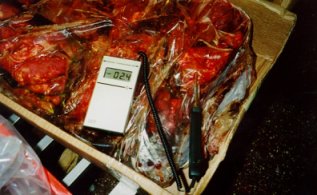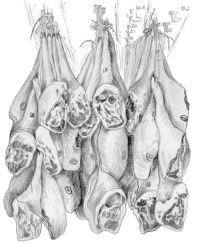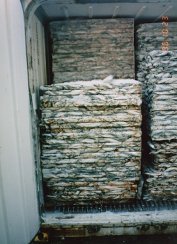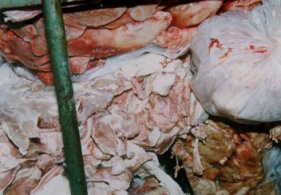Meat consists of skeletal muscle tissue, including fatty, connective and bone tissue, originating from slaughtered, skinned and gutted animals. Frequently transported types of meat are: cattle, pigs, calves, sheep and lambs. Meat is transported unpackaged or heat-sealed in plastic film or sewn into stockinette. Vacuum packaging is usual in particular for relatively small cuts of meat, such as steaks, minced meat etc.. Chilled meat is also described as fresh meat because, when correctly chilled, it retains the characteristics of fresh meat (see Figs. 108, 109).
 |
| Figure 108: Chilled beef: this beef has been stored at excessively low temperatures. Depending upon the receiver, this will result, at best, in depreciation of 20% and, at worst, the meat will have to be frozen with consequent depreciation of 40-50%;
Photo: Förster/Ahrens [12] |
 |
Figure 109: Chilled meat hanging from hooks in a container; stacking may cause loss of juices. |
Fish is more highly perishable than meat. This high perishability is attributable to the protein-decomposing enzymes which are still active at low temperatures and the large proportion of psychrophilic microorganisms associated with fish. Flash-frozen fish (which is the best quality as there are no crystals within the cells) are heat-sealed in strong plastic film and packaged in hard board cartons. Fish is often frozen in blocks with water and packed into containers (see Fig. 110).
 |
Figure 110: Fish in blocks: to provide protection from freezer burn (drying-out of the frozen fish) and to facilitate handling, fish is flash-frozen in blocks with water. The portions broken away from the lower blocks in the right-hand stack are attributable to rough handling rather than thawing. Photo: Förster/Ahrens [12] |
Meat/fish are goods displaying 3rd order biotic activity (BA 3), in which respiration processes are suspended but in which biochemical, microbial and other decomposition processes still proceed.
Meat/fish have a high water content (50 - 75%) and thus belong in water content class 3 (WCC 3).
While fruit and vegetables are naturally resistant to microorganisms and infestation is usually initiated by mechanical damage, the decomposition activity of microorganisms in meat/fish begins as soon as rigor mortis subsides (see Table 17).
| Fruit/vegetables | Meat/fish | |
| 1. Cell walls | Cell walls consist of cellulose and are thus robust | Cell walls consist of proteins and are thus not very strong |
| 2. Water content | Goods with a high water content (WC > 90%). WCC 3 | |
| 3. Respiration processes | Living organs in which respiration processes predominate - 2nd order biotic activity. BA2 |
Goods in which respiration processes are suspended, but in which decomposition processes still proceed - 3rd order biotic activity. BA 3 |
| 4. Viability | Maintenance of viability balanced against reduction of respiration ("dormancy temperatures") | Dead tissue, cells dead |
| 5. Refrigeration temperatures | Refrigeration temperatures for fruit must be several degrees above freezing point, as there is a risk of chilling damage | Refrigeration temperatures may be very close to freezing point. Chilling damage may, for example, take the form of freezer burn |
| 6. Ripening ability | Ripening ability lost if overcooled | No ability to ripen |
| 7. Resistance to microorganisms | Naturally resistant to microorganisms. Infestation usually occurs only after mechanical damage. | No natural resistance to microorganisms. Decomposition begins once rigor mortis subsides, in the case of fish due to accompanying psychrophilic bacteria |
Table 17: Comparison of chilled goods of vegetable and animal origin
As highly perishable foodstuffs, meat/fish require particular temperature, humidity/moisture and ventilation conditions (SC VII). Due to their low biotic activity, they generate no heat within the cargo and thus also do not require a supply of fresh air. Meat/fish must be packed in the container when frozen. The only heat which has to be removed from this frozen cargo block is that originating from outside. It is thus sufficient to circulate cold air around the outside of the cargo block.
Refrigerated containers are suitable for temperature-controlled container transport. Very highly perishable tuna has recently begun to be transported in special low temperature refrigerated containers which are capable of maintaining transport temperatures of as low as -60°C (see Section 15.3.1.3).
Transport instructions and damage
Meat and fish are highly perishable due to their high protein and water content and their fat content and postmortem biochemical and microbiological changes make them unfit for consumption.
Autolysis (self-digestion) may be caused by enzymes within the meat and takes the form of "putrefaction" resulting in softening and greenish discoloration of the meat and a foul odor due to the formation of hydrogen sulfide (H2S).
One type of bacterial spoilage which may be mentioned is the psychrophilic spoilage which is caused by the psychrophilic bacteria accompanying the fish and by bacteria in the refrigerated container atmosphere. Such organisms form coffee-brown to yellowish colonies on the surface of the meat/fish and, being fluorescent or flavobacteria, may also luminesce. This type of spoilage is caused by unhygienic slaughtering and the bacteria continue to grow at chilling temperatures.
Molds may also colonize poorly cleaned areas, with the abdominal muscles, shoulder blades and neck area being at particular risk in meat. Affected meat develops a musty odor.
Fatty meat, such as pork, and oily fish have a tendency to become rancid due to oxidation of the unsaturated fatty acids and the plastic material used in packaging should thus provide the best possible oxygen barrier.
Chilled meat is transported at temperatures close to freezing point.
The aims of chilling are as follows:
- to inhibit autolytic changes
- to prevent spoilage due to microorganisms
- to retain the freshly slaughtered state of the meat
The use of "protective atmospheres", such as CO2, has extended the range of chilled meat transport operations, e.g. from Australia to Europe. A CO2 content of approx. 10 - 12% suppresses surface growth of aerobic molds and ensures a 4 - 5 fold reduction in the rate of development of aerobic spoilage bacteria. A higher CO2 content, however, results in more rapid browning of the meat and greying of the fat.
Sides of beef are, for example, transported suspended as the pressure caused by stacking would result in loss of meat juices (see Fig. 109). Relative humidity should be 80 - 85%; lower values increase weight loss and drying-out, while higher values increase the activity of microorganisms.
Frozen meat/fish
Frozen meat/fish is flash-frozen to a core temperature of -18°C - -27°C and strict compliance with the freezing chain must be ensured during transport. Temperature variations of > 1°C result in recrystallization. The minute ice crystals formed within the cells during the flash-freezing process could then grow into large crystals. Variations in temperature are associated with continual slight thawing and refreezing. Since small ice crystals have a higher vapor pressure than larger ones, they will melt more rapidly when the temperature rises, while on cooling the same effect means that the water is preferentially deposited as ice on the larger ice crystals. The large ice crystals rupture the cell walls, as a result of which considerable drip loss occurs on subsequent thawing of the meat/fish. The meat becomes dried out and its quality is impaired.
When packing refrigerated containers, it must be checked whether thawing has occurred. Clear signs of thawing are: discolored protective coverings, distortion and dark muscle tissue color or formation of "snow" inside the plastic bags.
With frozen meat/fish, relative humidity may be 90 - 95% because the low temperatures very largely suppress microbial growth and only slight weight loss occurs. Excessively low humidities result in drying-out and, ultimately, freezer burn, which is irreversible (see Figs. 110, 111). However, at subzero temperatures, humidity/moisture can only be changed structurally by means of the size of the evaporator surface in the container's refrigeration unit. Film packaging, compact stowage, little free space above the cargo (only pack up to the red line), avoidance of thermal bridging (intact containers) and precise compliance with temperature prevent the goods from drying out during transport.
 |
Figure 111: Freezer burn on beef tongues The thickness of the frost layer may subsequently be used to determine the duration of storage. Photo: Nielsen [24] |
Frozen meat splinters like wood, so dropping and impact result in breakage. It is accordingly sensitive to other mechanical stresses, e.g. slipping due to poor stowage, during transport and handling operations.
Table 18 shows the temperatures for frozen animal products, which are generally lower than -18°C, at which the majority of the cytosol is frozen.
| Cargo type | Temperature in °C |
| Eel | -20 |
| Butter | -18 - -15 |
| Shelled egg | -20 - -15 |
| Fat | -20 - -15 |
| Fish | -30 - -17 |
| Fish oil | -30 - -20 |
| Meat, mutton | -18 - -15 |
| Meat, beef | -23 - -20 |
| Meat, pork | -18 - -15 |
| Poultry | -25 - -18 |
| Herring | -30 - -22 |
| Spiny lobster tails | -15 |
| Horse meat | -12 |
| Whale meat | < -15 |
Damaged cartons should not be packed in the container as weight loss combined with degradation of quality due to freezer burn may occur. Fish must, on principle, be stowed alone in a refrigerated container because odor tainting must always be expected.
The sides of a refrigerated container are corrugated, so that the air can flow properly around the cargo block. Care must be taken during packing that all the cartons are stowed in such a way that they cannot slip into the corrugations even in rough seas. It must be ensured that the container is at the specified subzero temperature before packing begins.